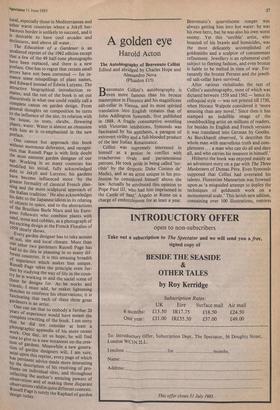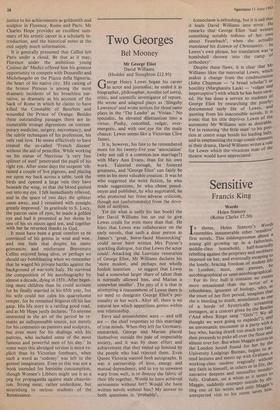A golden eye
Harold Acton
The Autobiography of Benvenuto Cellini Edited and abridged by Charles Hope and Alessandro Nova (Phaidon £15)
Benvenuto Cellini's autobiography is even more famous than his bronze masterpiece in Florence and his magnificent salt-cellar in Vienna, and its most spirited translation into English remains that of John Addington Symonds, first published in 1888. A fragile consumptive wrestling with Victorian inhibitions, Symonds was fascinated by his antithesis, a paragon of extrovert virility and a full-blooded product of the late Italian Renaissance.
Cellini was supremely interested in himself as a genius in conflict with treacherous rivals and parsimonious patrons. He took pride in being called 'ter- rible' by the despotic Duke Cosimo de' Medici, and as an artist unique in his pro- fession he considered himself above the law. Actually he attributed this opinion to Pope Paul III, who had him imprisoned in the Castle of Sant' Angelo in Rome on a charge of embezzlement for at least a year.
Benvenuto's quarrelsome temper was always getting him into hot water: he was his own hero, but he was also his own worst enemy. Yet this 'terrible' artist, who boasted of his brawls and homicides, was the most delicately accomplished of goldsmiths and a sculptor of consummate refinement. Jewellery is an ephemeral craft subject to fleeting fashion, and even bronze is liable to be melted in time of war. For- tunately the bronze Perseus and the jewell- ed salt-cellar have survived.
After various vicissitudes the text of Cellini's autobiography, most of which was dictated between 1558 and 1562 — hence its colloquial style — was not printed till 1730, when Horace Walpole considered it 'more amusing than any novel.' Since then it has stamped an indelible image of the swashbuckling artist on millions of readers, for besides its English and French versions it was translated into German by Goethe.
As Burckhardt observed, 'it describes the whole man with marvellous truth and com- pleteness... a man who can do all and dare
all, and who carries his measure in himself.' Hitherto the book was enjoyed mainly as an adventure story on a par with The Three Musketeers of Dumas Pere. Even Symonds
supposed that Cellini had overrated his talents. Florentine Mannerism was frowned upon as 'a misguided attempt to deploy the techniques of goldsmith work on a monumental scale.' This lavish new edition, containing over 100 illustrations, restores justice to his achievements as goldsmith and sculptor in Florence, Rome and Paris. Mr Charles Hope provides an excellent sum- mary of his artistic career in a scholarly in- troduction, and the historical notes at the end supply much information.
It is generally presumed that Cellini left Paris under a cloud. Be that as it may, Florence under the ambitious young Cosimo de' Medici offered him his greatest opportunity to compete with Donatello and Michelangelo on the Piazza della Signoria, the heart of his native city. His casting of the bronze Perseus is among the most dramatic incidents of his breathless nar- rative, as dramatic as his account of the Sack of Rome in which he claims to have killed the Constable of Bourbon and wounded the Prince of Orange. Besides these outstanding passages there are in- numerable strange digressions on contem- porary medicine, surgery, necromancy, and the subtle techniques of his profession, his only real love. He seems effectively to have treated the so-called 'French disease' without the aid of penicillin. While working on his statue of Narcissus 'a very fine splinter of steel' penetrated the pupil of his right eye. After some days the surgeon 'ob- tained a couple of live pigeons, and placing me upon my back across a table, took the birds and opened a large vein they have beneath the wing, so that the blood gushed out into my eye. I felt immediately relieved, and in the space of two days the splinter came away, and I remained with eyesight greatly improved.' In gratitude to S. Lucy, the patron saint of eyes, he made a golden eye and had it presented at her shrine by one of his six nieces aged ten, and together with her he returned thanks to God.
It must have been a great comfort to be convinced of his genius in weal and woe, and one feels that despite his many grievances and misfortune Benvenuto Cellini enjoyed being alive, or perhaps we should say bombinating when we remember that he waged his private battles against the background of war=torn Italy. He survived the composition of his autobiography by almost a decade, dying in 1571. After beget- ting more children than he could account for he finally married in his 65th year, but his wife could not calm his quarrelsome temper, for he remained litigious till his last gasp. His life story is a rattling good read, and as Mr Hope justly declares: `To anyone interested in the art of the period he re- mains an indispensable source, not merely for his comments on painters and sculptors, but even more for his dealings with his patrons, who included some of the most famous and powerful men of his day.' In some ways this abridged version is more ex- plicit than its Victorian forebears, when such a word as 'sodomy' was left to the genteel imagination. Even so this was not a book intended for feminine consumption, though Women's Libbers might use it as a peg for propaganda against male chauvin- ism. Strong meat, rather underdone, but nourishing to serious students of the Renaissance.











































 Previous page
Previous page